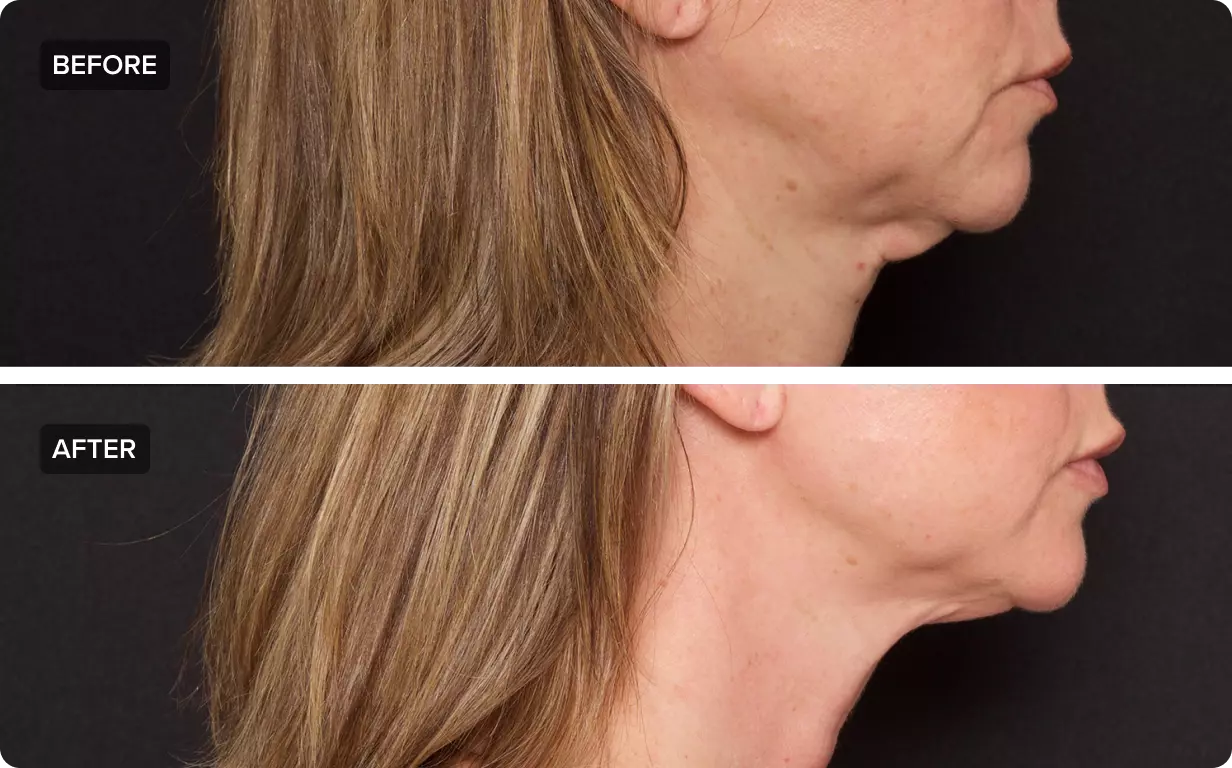The term “Chin Thread Lift” refers to a cosmetic procedure that is designed to enhance the appearance of the chin and jawline. It is a non-surgical technique that involves using special threads to lift and tighten sagging skin in the chin area.
During a chin thread lift, a medical professional inserts thin, dissolvable threads into the skin through small incisions. These threads contain tiny barbs or cones that help anchor and lift the skin. Once the threads are in place, they can be gently adjusted to achieve the desired lifting effect. The threads stimulate collagen production, which further helps to improve the firmness and elasticity of the skin.
The procedure is generally performed under local anesthesia and can take about 30 minutes to an hour, depending on the extent of the treatment. Patients may experience some mild swelling, bruising, or discomfort after the procedure, but these effects usually subside within a few days.
Chin thread lifts are popular because they provide relatively quick and noticeable results compared to more invasive surgical procedures like chin augmentation or facelifts. However, it’s important to note that the effects of a thread lift are not as long-lasting as those of surgery. The threads gradually dissolve over time, typically within six to twelve months, and their lifting effect diminishes accordingly.
If you’re considering a jaw thread lift or any cosmetic procedure, it’s essential to consult with a qualified and experienced medical professional who can assess your individual needs, guide you through the process, and help you make an informed decision.

Double chin thread lift
The term “Double chin thread lift” refers to a specific type of thread lift procedure that focuses on improving the appearance of a double chin. A double chin is characterized by excess fat or sagging skin beneath the chin, which can create the appearance of a second chin.
In a double jaw thread lift, similar to a regular thread lift, dissolvable threads with barbs or cones are inserted into the skin through small incisions. These threads are strategically placed to target the specific areas of concern and lift the sagging skin.
The threads used in a double jaw thread lift can have different mechanisms of action. Some threads are designed to physically lift and tighten the skin, while others can help dissolve fat cells or stimulate collagen production to improve the contour of the chin and jawline.
The procedure is typically performed under local anesthesia and can take around 30 minutes to an hour, depending on the complexity of the treatment. After the procedure, patients may experience mild swelling, bruising, or discomfort, but these effects are temporary and usually resolve within a few days.
It’s important to note that a double chin thread lift is not a permanent solution for a double chin. The threads used in the procedure will eventually dissolve, and the results are not as long-lasting as those achieved through surgical interventions such as liposuction or a neck lift. However, double chin thread lifts can provide noticeable improvement in the appearance of the chin and jawline without the need for surgery.
As with any cosmetic procedure, it’s essential to consult with a qualified and experienced medical professional to determine if a double chin thread lift is suitable for you. They will be able to assess your specific needs, discuss the potential risks and benefits, and guide you through the process.

benefits of chin thread lift
Chin thread lifts offer several potential benefits for individuals seeking facial rejuvenation and enhancement. Some of the key benefits of a jaw thread lift procedure include:
- Non-surgical: Chin thread lifts are minimally invasive and do not require extensive incisions or general anesthesia, unlike surgical procedures such as chin augmentation or facelifts. This means a reduced risk of complications, minimal scarring, and a quicker recovery time.
- Lifting and tightening effect: The threads used in a chin thread lift are designed to lift and tighten sagging skin in the chin and jawline area. This can result in a more defined and youthful appearance, improving the contour of the chin and jawline.
- Stimulates collagen production: The insertion of threads into the skin stimulates collagen production, which is essential for maintaining skin elasticity and firmness. Increased collagen production can lead to long-term improvements in skin quality and texture.
- Natural-looking results: Chin thread lifts can provide natural-looking results that enhance the existing features of the face. The threads are carefully placed to achieve the desired lifting effect while maintaining a balanced and harmonious appearance.
- Quick procedure and minimal downtime: The procedure itself is relatively quick, typically taking around 30 minutes to an hour. It is often performed on an outpatient basis, allowing individuals to return to their regular activities relatively quickly. While some mild swelling, bruising, or discomfort may occur after the procedure, these effects typically subside within a few days.
- Adjustable and customizable: Chin thread lifts offer flexibility in terms of adjusting the threads during the procedure to achieve the desired results. The procedure can be tailored to address specific concerns and meet individual aesthetic goals.
It’s important to note that the results of a chin thread lift are not permanent, as the threads used in the procedure gradually dissolve over time. The longevity of the results can vary depending on factors such as individual skin characteristics and lifestyle factors.
As with any cosmetic procedure, it’s crucial to consult with a qualified and experienced medical professional who can evaluate your specific needs, discuss the potential risks and benefits, and help you determine if a jaw thread lift is the right option for you.
Risk of chin thread lift
While chin thread lifts are generally considered safe, like any medical procedure, there are potential risks and complications to be aware of. It’s important to discuss these risks with a qualified medical professional before undergoing the procedure. Some of the possible risks associated with a jaw thread lift include:
- Infection: There is a risk of infection at the site of the thread insertion. It is crucial to follow proper post-procedure care guidelines and keep the treated area clean to minimize the risk of infection.
- Bruising and swelling: Some degree of bruising and swelling is common after a chin thread lift. While these effects are usually temporary and resolve within a few days to weeks, they can be more pronounced in some individuals.
- Discomfort or pain: Mild discomfort or pain at the site of the thread insertion may occur after the procedure. This can typically be managed with over-the-counter pain medications and usually subsides within a few days.
- Thread migration or visibility: In rare cases, the threads used in the procedure may move from their intended position or become visible beneath the skin. This can result in an uneven or unnatural appearance. It is important to choose an experienced and qualified medical professional to minimize the risk of these complications.
- Allergic reactions: Although uncommon, some individuals may have an allergic reaction to the materials used in the threads. It is essential to inform your medical professional about any known allergies or sensitivities you have before the procedure.
- Tissue damage or injury: There is a small risk of tissue damage or injury during the insertion of the threads. This can include nerve damage, blood vessel injury, or scarring. Choosing a skilled and experienced medical professional can help minimize these risks.
It’s important to note that the risks and complications associated with a jaw thread lift are generally less severe compared to surgical procedures. However, it’s essential to have a thorough consultation with your medical professional, discuss your medical history, and follow all pre- and post-procedure instructions to minimize the risk of complications.
Every individual’s experience and response to the procedure may vary. It’s crucial to have realistic expectations and thoroughly discuss the potential risks and benefits with your medical professional before deciding to undergo a chin thread lift.
chin thread lift before and after
jaw pain after thread lift
Experiencing jaw pain after a thread lift procedure is not a common or expected side effect. However, it is possible for some individuals to experience discomfort or pain in the jaw area following the procedure. There could be several reasons for this:
- Inflammation or swelling: After any cosmetic procedure, including a thread lift, some degree of inflammation and swelling is normal. Swelling in the surrounding tissues can potentially cause discomfort or pain in the jaw area.
- Tension or muscle strain: During the thread lift procedure, the tissues in the treated area, including the jawline, may experience some tension or pulling. This tension can occasionally result in muscle strain or discomfort in the jaw.
- Temporomandibular joint (TMJ) issues: In some cases, individuals may already have pre-existing TMJ issues or jaw-related conditions. The procedure itself may exacerbate these underlying issues, leading to jaw pain.
If you are experiencing jaw pain after a thread lift, it is important to consult with your medical professional who performed the procedure. They can evaluate your specific situation, examine the area, and provide appropriate guidance or treatment options. They may recommend over-the-counter pain relievers, cold compresses, or other methods to manage the discomfort. In some cases, they may refer you to a specialist, such as a maxillofacial surgeon or a dentist, for further evaluation and treatment if necessary.
Remember, it is always crucial to communicate any post-procedure concerns or symptoms with your medical professional to ensure proper care and guidance.
Treatment of jaw pain after thread lift
If you are experiencing jaw pain after a thread lift procedure, there are several potential treatments and strategies that can help alleviate discomfort. It is important to consult with your medical professional who performed the procedure for an accurate diagnosis and personalized recommendations. They may suggest one or more of the following approaches:
- Pain medication: Over-the-counter pain relievers such as acetaminophen or ibuprofen may help reduce jaw pain. Follow the recommended dosage instructions and consult with your doctor or pharmacist if you have any concerns or underlying health conditions.
- Cold compresses: Applying a cold compress or ice pack to the affected area can help reduce inflammation and numb the area, providing temporary relief from jaw pain. Wrap the cold pack in a thin cloth or towel and apply it to the jaw for about 15 minutes at a time, several times a day.
- Heat therapy: In some cases, applying moist heat to the jaw area can help relax the muscles and alleviate pain. Use a warm towel or a heating pad set on a low or medium setting. Be cautious not to use excessive heat to avoid burns.
- Gentle jaw exercises: Your medical professional may recommend specific jaw exercises to help relax the muscles and improve mobility. These exercises should be performed gently and within your comfort level to avoid further strain or discomfort.
- Soft diet: Consuming soft foods that require minimal chewing can help reduce strain on the jaw muscles. Opt for foods like soups, smoothies, mashed potatoes, and yogurt until the jaw pain subsides.
- Avoid excessive jaw movement: Be mindful of activities that involve excessive jaw movement, such as chewing gum or biting into hard foods. Give your jaw ample rest and avoid any activities that exacerbate the pain.
- Follow-up with your medical professional: It is crucial to communicate your symptoms and concerns with your medical professional who performed the thread lift. They can provide personalized advice, evaluate your specific situation, and determine if further treatment or evaluation is necessary.
Remember, these are general recommendations, and the appropriate treatment for your specific case may vary. Always consult with your medical professional for personalized advice and follow their recommendations to ensure proper care and management of your jaw pain.



